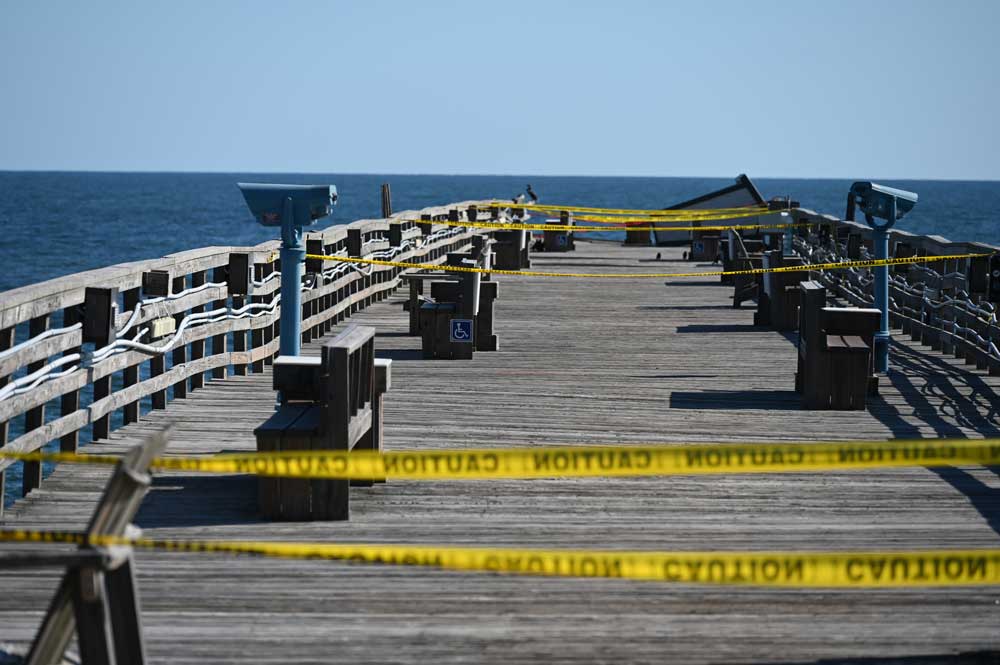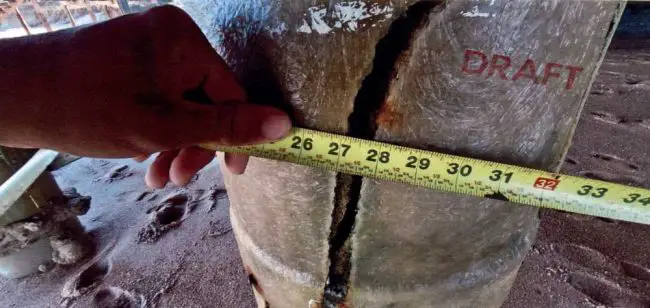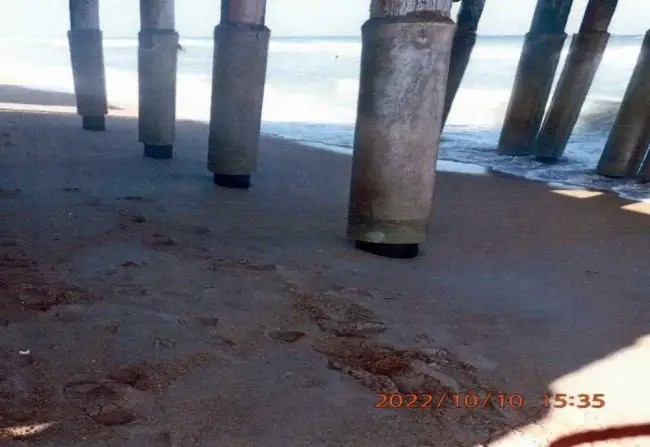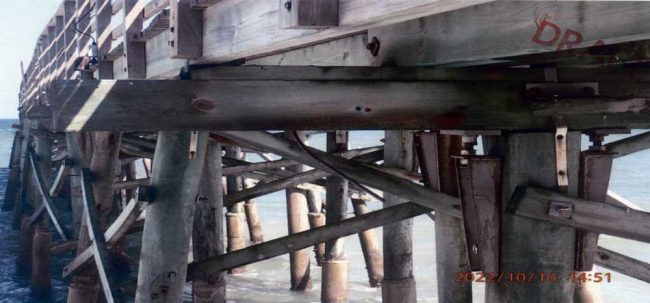
An engineering report that followed the post-Hurricane Ian inspection of the Flagler Beach pier is bad news for anyone hoping to see the pier reopened before it is demolished next year to make room for a new, concrete pier.
The report, by Mott MacDonald, a city consultant, describes a pier as all but in ruins following the passage of Hurricane Ian offshore last month, and not just because the storm lopped off another 120-foot section of pier: Even under the parts of the pier that remain, piles have disappeared, bracing has been severely damaged, and hardware has failed even on parts of the pier closer to the shore–parts not made of stainless steel.
The entire structure is severely damaged to the point that further collapses of sections of the pier during mildly heavy seas would not be surprising, because parts of it are hanging by piles’ equivalent of a thread. The entire length of the pier has been compromised by the carving out of huge amounts of sand from the sea floor beneath the water surface. The report’s details of damage are such that it is a wonder parts of the structure are still standing. The report does not address how any of that affects the Funky Pelican, the restaurant at the east end of the pier, beneath which sands have also been scoured in huge quantities. The restaurant is open, though the pier has been closed since Ian, awaiting the consultant’s report.
“Mott MacDonald recommends the City of Flagler Beach post the Fishing Pier (Pier) as unsafe for occupancy and entry and keep the Pier closed to public access and use,” Chad Lyner, an engineer with Mott MacDonald, wrote in his cover letter to the report on Friday.
The report precedes two meetings where the fate of the pier will be discussed this week. On Wednesday, the city is hosting a post-hurricane information forum at Santa Maria del Mar church in the city. The City Commission meets the next evening. City Manager William Whitson will present the Mott MacDonald report and seek “possible action regarding the pier cost benefit review.”
Two weeks ago Whitson said even rough repair costs could exceed $650,000. That was before the Mott MacDonald report’s details, which almost certainly push that cost well past $1 million. The city is scheduled to demolish the pier next year. The only question had been whether it was worth repairing the pier and opening it up for a few months, if not a few weeks by then, only to have it closed and demolished. (See: “What To Do With Flagler Beach Pier? City Caught Between Costly Repairs and Demolition.”

It is no small matter that the next item on the commission’s agenda, after the pier discussion, is another action item about raising utility costs on city customers for sewer, water, garbage and stormwater fees, and raising them substantially. The combination of the two items, plus the Mott MacDonald report, will make it nearly impossible for commissioners to justify reopening the pier. Already, two commissioners–Eric Cooley and James Sherman–are on record favoring an immediate and permanent closure until the new structure is built. Cooley reiterated that position today.
“I am all for starting early demolition,” he said. Cooley had not seen the MacDonald report yet, but was not surprised by its conclusions. “The sooner we get this out of the way, the sooner we are on the way to getting an upgraded and stable pier back.”
The city is planning for an 800-foot-long concrete pier on the same footprint as the existing pier, which was first built in 1928. The existing pier has gone through numerous reconstructions, having been battered and partly demolished by storms many times over the years. It has remained the single-most distinctive symbol of the city.
Complete costs for the new pier have not yet been tallied. Its reconstruction had at first been predicated on money from the Federal Emergency Management Administration (FEMA), after it was partly destroyed by Hurricane Matthew in 2016. But that cost was pegged at $12 million. The cost has risen since, to $15 to $18 million, according to Whitson. A combination of Matthew and Ian recovery dollars will be necessary to make those ends meet. The city is so far certain of only a little more than half that amount.

But while the MacDonald report will be a blow to pier lovers and to the city’s hopes of generating revenue from pier patrons–the pier has generated up to $3,000 in revenue on good days–the report will also buttress the city’s case for FEMA dollars in compensation for the Ian damage.
The report’s details are sobering.
The pier rests on timber pile “bents,” or sections of pier. The piles are 12 to 14 inches in diameter. Bents 19 to 13 “have failed and no longer exist,” the report states. (The numbers increase as the bents approach the shore, and suggest how far out the pier once stood.) Bent 20 has only one of four piles remaining. Bent 22 has only two of its four piles. Bent 22 has three of the four piles in place.
Just because the piles are in place elsewhere doesn’t mean they’re in good shape. Twenty-three piles are at least in part disconnected from the cap beam, and 13 of those are entirely disconnected. In other words, 13 piles are providing “no support to the caps, stringers and deck,” the report states. The piles support 12-by-12 timber caps that run the width of the pier. Transverse pile caps support “stringers” running east to west. Pile bents and piling are connected by 4-by-8 timber cross-bracing bolted diagonally.

Heavy seas “scoured out the ground line, exposing and suspending past pile jacket repairs” for up to 7 feet, compared to conditions after Hurricane Irma in 2017, so that “52 piles have excessive scour resulting in suspended pile jackets. Previously buried sections of piling now are exposed and unprotected against marine borers. All suspended pile jackets have cement fill missing.”
The epoxy seals on every single pile jacket are broken, missing, cracked or have failed. Pile jackets are suspended over sand bottoms, the sand having been scraped off. Cross-braces are no longer attached to the underside of the deck. A picture shows one cap beam 70 percent deteriorated. Another shows a pile so far bent that the leveling bolt is now at a severe angle. Some piles are gashed, in some cases with cracks up or down their lengths of almost an inch wide.

The report goes on in more details to describe what of the structure is still in good repair, and what isn’t. While the pier looks as if its midsection did not sustain the sort of damage more apparent at its eastern end, the report notes that substructure in that midsection has been heavily damaged. Sonar passes 600 feet to the east and 500 feet to the south did not reveal any large pieces of missing pier structure, though the pier baseline did show pile stubs. Those were studied, producing alarming observations: “Divers noted all the piles that were found were approximately 3-4 [feet] above the groundline,” the report states. “They noted hollow centers with heavy hard marine growth inside and out.” That suggests that, even while standing before the storm, the piles may not have been safe. Nor the pier.
The report lists all the necessary repairs and recommends that swimmers be kept away from the structure.
![]()




























Thomas Kaspar says
This is not something historically new . I thought they had to match the State for a 1200 foot concrete piling wood top pier . Not going to catch fish unless it goes at least 1000 preferable with a T at the end but thats just me since 1961 , lol .
PS the A1A street presentation of Funky Pelican is an embarrassing third world grease trap piece of shit .
Jimbo99 says
This pier should be demolished as part of the rebuild. Whether any pier should even be rebuilt at that exact location is yet another topic of discussion. Personally, I would not rebuild it there, in spite of anyone’s arguments that it’s always been there. The erosion and there just isn’t enough beach head to attach a new pier, even a concrete pier. The closest example(s) of the flaws of a new concrete Flagler pier at that location are best demonstrated by what the St Augustine pier was rebuilt as Or even what the Jacksonville Beach pier was rebuilt as. The Ormond Beach pier has been gone for decades & never rebuilt. A new pier era for Flagler Beach doesn’t include a concrete pier built at the exact location or +/- the 3 way intersection of east FL-100 & North/South A1A. Anyone spending the millions there for even suggesting it, knowing the erosion issues as the pier has lost sections in recent storms is a fool of the highest order. The most difficult part of this, keeping the general public away from the ruins. And there are people that will want to eat what appears to be the relatively safer sections. But those people are always going to be like that.
Here’s a dock that collapsed in Miami for a restaurant. One doesn’t need to be an engineer to know this is where that pier is headed. To throw more money to fix that for the sake of tourism is gross incompetence, knowing the rebuild was going to occur in 2023 anyway. I doubt there are any insurance companies that are going to insure that affordably at the very least. Heck, they won’t insure a 20+ year old asphalt shingle roof for a residential, why would they insure a pier that’s crumbling with every wave that rhythmically crashes onto the shoreline/
https://www.nbcmiami.com/news/local/divers-on-scene-after-deck-of-shuckers-bar-grill-collapsed-authorities/1940368/
https://www.nbcmiami.com/news/local/divers-on-scene-after-deck-of-shuckers-bar-grill-collapsed-authorities/1940368/
https://www.nbcmiami.com/news/local/divers-on-scene-after-deck-of-shuckers-bar-grill-collapsed-authorities/1940368/
Mischa Gee says
I agree. We now have serious erosion along the coastline. Rebuilding this monstrosity makes no sense. Those millions of dollars might be better spent possibly putting in some rock jetty’s to slow down continued erosion.
A1A may permanently become part of the ocean next. Our barrier islands are at risk of completely disappearing and people are concerned about a pier? Honestly, when did Americans lose their capacity to see reality and think critically.
Take down that pier yesterday. It doesn’t need to fall into the ocean and add to all the pollution our oceans already endure. Don’t build another, until you slow erosion substantially.
1923 was 100 years ago and the world has radically changed. We need better vision regarding the future and a pier probably is the least of our worries.
rick stevens says
🥲
rick stevens says
Nothing gold can stay
John says
Great report. I am sure it will read well by those at FEMA that control the purse strings. Here’s hoping they pay for the demolition AND reconstruction.
Hmmm says
The pier is made of popsicle sticks and the plan for “saving” A1A was dumping more sand on the beach. Comical.
Judy says
The tape has been removed. Why?